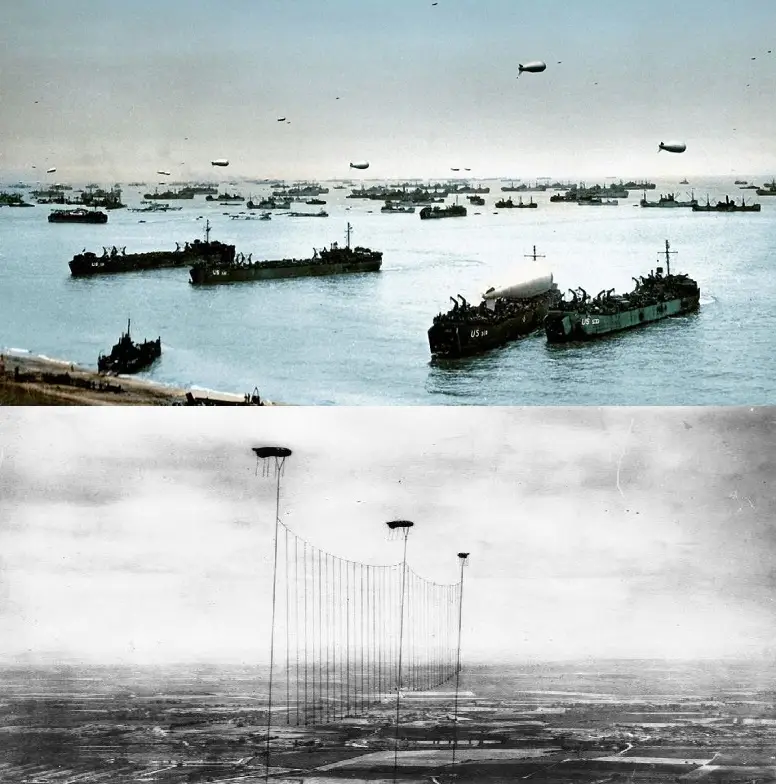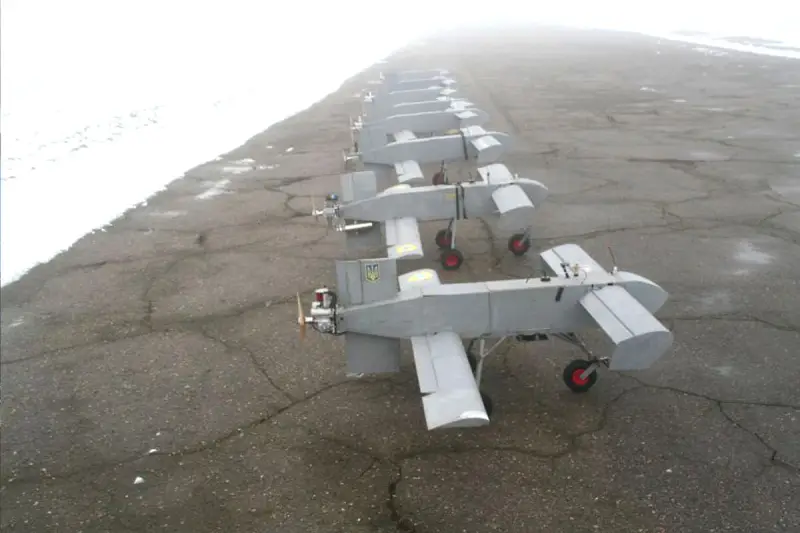Barrage balloons: guarding industrial facilities and the fuel and energy complex

Due to the lack of real success on the battlefield the intensity of strikes caused by Ukrainian cruise missiles and kamikaze UAVs will only increase – we talked about this in December last year. Now we can clearly assess the reality of this forecast in practice - just compare how many air attack weapons our air defense systems shot down in December 2023, and how many in late March - early April 2024.
Not only the number of Ukrainian air defense systems has increased, but also their nomenclature. The enemy is attacking not only and not so much military targets, but also industrial facilities, infrastructure and the fuel and energy complex. Attacks increasingly began to be carried out on objects located deep in the territory of the Russian Federation (RF), at a greater distance from the line of combat contact (LCC) and the borders with Ukraine.
There is information about the appearance of kamikaze unmanned aerial vehicles (UAVs) in the Armed Forces of Ukraine (UAF) with a range of up to 2500 kilometers, and according to some information - up to 3300 kilometers; the search for targets in Russia and planning a strike are carried out using intelligence and control infrastructure and communications between the United States and other NATO countries.
A significant increase in the number of airborne attack systems of all types, primarily low-flying long-range kamikaze UAVs, will not make it possible to provide air defense for all types of military and industrial facilities. However, we have experience almost a century old, gained during the Second World War (WWII) - the Great Patriotic War (WWII), which simply must be used in our time.
WWII/WWII barrage balloons
Already during the Second World War aviation became a formidable force to be reckoned with. Compared to our time, the number of aircraft of various types produced by industrial enterprises of the warring parties and taking part in hostilities was greater by one, and in a number of positions, by two orders of magnitude. However, the lack of high-precision technology in those days weapons in large-scale production (precision weapons already existed in small quantities) forced the warring parties' aircraft to approach the target directly to bomb or launch unguided missiles. Cruise missiles also appeared at that time, however, their low guidance accuracy made them more of a weapon of intimidation.

"Fields" of barrage balloons
Considering the intensity of raids on cities and industrial facilities, fighter aircraft and air defense systems of that time - anti-aircraft artillery - could not provide guaranteed cover for protected objects, and therefore additional measures were required.
One of the solutions was the use of barrage balloons filled with hydrogen, attached to metal cables at an altitude of about 2000-4500 meters. Cables could also be stretched between several balloons, forming something like a network. If the cable were hit, the plane could literally be cut into several parts.
For example, the Moscow Air Defense Front, organized by a decree of the USSR State Defense Committee dated April 5, 1942, had 1060 barrage balloons. In Leningrad, barrage balloons were manufactured and deployed even during the siege, including the production of hydrogen to fill them. In London, balloons ensured the defeat of up to 4% of German V-1 cruise missiles.

Barrage balloons over ships carrying troops
It may seem that the total enemy losses from barrage balloons were small, but they forced the enemy to deviate from course, reduced the accuracy of bombing, and “exposed” enemy bombers to anti-aircraft artillery and fighter fire. It got to the point that bombers began to be equipped with devices for capturing cables with pyrotechnic charges to cut them.
Balloons shot down by the enemy were quickly repaired and took to the air again. Periodically, about once a month, the balloons needed to be refilled due to hydrogen leakage.
Features of the use of low-flying airborne missiles
First of all, it is necessary to understand that the main threat to us now is posed by low-flying airborne attack systems, the route of which is laid by the Western curators of Ukraine, taking into account the terrain, the location of radar stations (radars) and anti-aircraft missile systems (SAM). If the enemy raises the flight altitude of the kamikaze UAVs, they will become easy prey for Russian air defense systems.
The use of kamikaze UAVs at high altitudes, about 4-5 kilometers, makes sense only if the attacker is able to launch more kamikaze UAVs than the defender can shoot down, thereby depleting its air defense. The number of Ukrainian kamikaze UAVs is currently not enough to overload the Russian air defense; more precisely, they can try to do this, but infrequently and at a limited distance from the LBS line and the borders of Ukraine.

Ukrainian long-range kamikaze UAV AQ 400 Scythe with a flight range of up to 750 kilometers
Since Ukraine currently cannot afford a truly massive use of kamikaze UAVs, its strikes are more of a terrorist nature and are carried out in the hope that at least a small part of the kamikaze UAVs will be able to “leak” through the barriers of Russian air defense systems.
Nevertheless, even a limited number of Ukrainian kamikaze UAVs causes significant damage to Russian industrial facilities and the fuel and energy complex, and therefore it is advisable to consider the possibility of deploying barrage balloons made at the modern technological level, taking into account the characteristics and tactics of using Ukrainian kamikaze UAVs.
Barrage balloons 2024
As we said above, the use of Ukrainian kamikaze UAVs in the depths of Russian territory is only possible when they fly at low and ultra-low altitudes, using the terrain, natural and artificial hills - clearings in the forest, river beds, clearings along roads, etc. As soon as Ukrainian UAVs gain altitude, there is a high probability that they will be detected and destroyed by Russian air defense systems.
Thus, the use of barrage balloons can be considered in two directions. The first is the blocking of possible low-altitude flight routes of kamikaze UAVs. The second is the direct protection of objects that could potentially be attacked and whose destruction could lead to significant consequences.
Accordingly, work within the first direction can only be carried out by public or private structures, on the instructions and under the control of the RF Ministry of Defense, taking into account 3D terrain maps, as well as the location of the radar and air defense systems, in such a way as to force the enemy kamikaze UAV to gain altitude and expose yourself to our anti-aircraft missiles (or it is useless to die by crashing against deployed barriers).
In turn, work in the second direction, direct covering of objects with barrage balloons, can be carried out directly by the owners of these objects, in agreement with certain services (for example, taking into account air traffic safety, so that some ambulance helicopter does not fly in).

Schemes of placement and fastening of Soviet barrage balloons
Considering that we do not need to fight high-altitude targets, the height of the rise of barrage balloons can be about 300-500 meters, and even less for barrage balloons that directly cover objects. As a result, the dimensions of the balloons may be smaller than those used during WWII/WWII, and they may be produced in a much larger series.
If WWII/WWII barrage balloons carried metal cables capable of cutting a bomber or attack aircraft, then our goal is fairly light kamikaze UAVs made of plastic, wood or composite materials, less often of thin metal, moving at a speed of less than 200 kilometers per hour , that is, for their damage-destruction, cable-nets made of composite fibers may be sufficient.
The balloons themselves can also be made of modern materials that are lighter and capable of holding a filler gas longer, which can be a mixture of helium and hydrogen (15% hydrogen and 85% helium), phlegmatized hydrogen - a mixture of hydrogen with inert gases or freons ( with stirring the mixture to eliminate the possibility of its separation). Pure hydrogen can also be used; it is safe without a mixture with air, and special sensors can be installed to monitor changes in the composition of the mixture (diffusion of hydrogen and oxygen).
Thus, we will get barrage balloons placed at an altitude of 100-500 meters, with nets made of composite materials with cells suspended underneath them, with a pitch of 1x1 m or even 0,5x0,5 m. It is possible that it is advisable to place them in two rows, and the networks between them are even two or three rows long.

Barrage balloons over London
Yes, of course, such a solution will cost money, but hardly more than a destroyed distillation column at an oil refinery or losses from its downtime and repairs. The same can be said about many other industrial facilities, as well as the fuel and energy complex.
Conclusions
The use of barrage balloons to protect industrial facilities and the fuel and energy complex from attacks by Ukrainian kamikaze UAVs that have passed the air defense lines will minimize or even eliminate the consequences of their attacks.
Barrage balloons are a time-tested solution that was used during WWII/WWII; the production and deployment of barrage balloons was carried out even in besieged Leningrad.
It is important that barrage balloons are not weapon systems; their deployment by civilian structures from an organizational point of view can be much simpler and faster than the deployment of any active means of countering enemy kamikaze UAVs. Thus, industrial enterprises, holdings and other government and commercial structures can now begin to improve the security of their facilities.
Information